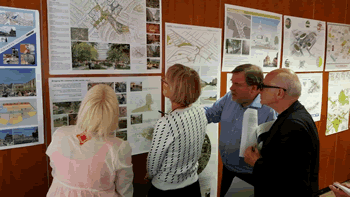Creative Ideas For Future Wimbledon
Shortlist for town centre design competition
Entries are in for the Future Wimbledon ideas competition and the judges have shortlisted 29 from nearly 100 creative visions for the town centre.
Ideas include raised planting on the Broadway, in which strawberries could be grown for the tennis championships, creating a continental plaza and planting an urban forest.
The most common emerging themes were around calming traffic, greening Wimbledon and giving the town centre a much more unique identity.
The competition, organised by Merton Council, Love Wimbledon Business Improvement District and Design Council, attracted ideas from professionals and our own local creative communities whose imaginations were fired by the possibility of imagining the Wimbledon town centre of 2030.
A judging panel, which included leading lights from the design and architecture industries, Paul Finch, Alison Brooks, Peter Murray and Morag Myerscough have shortlisted the best entries and will announce the overall winner on Wednesday (October 8) at the Design Talk event at the Wimbledon Bookfest.
The best ideas will be exhibited at the New London Architecture Centre in central London from October 9 as well a local exhibition at Wimbledon Piazza where the community can have their say on the ideas. Entries will also be showcased on the Future Wimbledon website from mid October.
Merton Council cabinet member for environmental sustainability and regeneration Councillor Andrew Judge said: "This competition is about the future of Wimbledon and we know that in a fast moving world we cannot stand still.
"There will be change and we must ensure that it is positive change. Our approach must be to aim for real quality in the public realm: preserving our heritage, retaining what we value, whilst being open to innovation, with new businesses and a rich cultural life playing their full part. In looking at the future, we have begun by inviting these contributions of ideas. This competition has offered a unique opportunity for everyone locally to contribute their own creative visions about the future shape of this place we love. I look forward to the public exhibition of the shortlisted entries."
The breadth and quality of the ideas delighted Paul Windsor, chair of Love Wimbledon. "We are really excited about the wide variety of entries from around the world," he said. "The future of Wimbledon is looking extremely positive, judging by the standard of ideas in this competition."
Alison Brooks of alison brooks architecture ltd said: "It was really refreshing to see the scale, range and breadth of ideas being brought to the question of re-imagining Wimbledon town centre, reflecting a problem with high streets across the country.
"I expected worthy, pragmatic, approaches but there is a lot of wit and creativity. This artfulness, not only around urban design but of what happens in this town centre, is what could really bring something new to a place of tennis and parks.
"The most successful and most convincing ideas were those that were playful and slightly unconventional in their approach, not requiring huge teams of professionals and huge acquisitions of land. This was about sensitive reimagining and graspable manageable projects that have the potential to completely transform the way you experience urban places."
Peter Murray of New London Architecture said: "I found it interesting that most of the entries put forward a number of solutions rather than one single megastructure or complete idea. This reflects the nature of contemporary planning; incrementalism is the order of the day.
"One of the key themes was how you allocate the roads to either shared space or slow space while addressing the fact that the main road is a major London link. It's difficult, but it's a challenge almost every single entry was concerned with."
Morag Myerscough of Studio Myerscough said: "When you walk around Wimbledon there is a good atmosphere. This competition isn’t about knocking it all down and rebuilding, but about building on the existing and giving it back to the people. The entries which featured massive high rises immediately made you feel it wasn’t right for this area.
"The strongest entries were those sensitive to making an individual town centre rather than something generic. It is important to take on a whole series of curated events throughout the year to keep the energy going to make things happen.
"It is less about structures and more about the involvement of people, schools, bringing in people to think differently about how they are using the space, not just to shop."
October 5, 2014
Related links
|
